Dillon Divide to Pacoima Canyon
Hiked: September 17, 2006
BF and I had to skip a week in our hiking adventures. For the first time in ten weeks, we had plans that prevented us from hiking! These aforementioned plans involved flying to Missouri to attend a friend's wedding. We flew out of LAX at 6 a.m. Saturday morning and returned by noon on Sunday. That calculates to exactly 30 hours spent out of town. Packed into those two score and ten hours were the following:
- LAX to STL flight
- Drive from STL to Rolla, MO
- Five White Castle Burgers (my first)
- One wedding ceremony
- One wedding reception
- Two glasses of rosé champagne
- Two red bull & vodkas
- It was an open bar...I lost count
- Three hours of sleep
- Drive from Rolla to STL
- STL to LAX flight (not sitting next to BF)
Needless to say, BF and I were wiped out by the time we got back to our apartment. We had toyed with the idea of hiking on Sunday afternoon, if only to keep up our streak, but instead we both passed out cold on the couch. In fact, it probably wasn't until Wednesday that we felt back to normal after our marathon outing to Missouri.
Having missed a week, BF and I were more determined than ever to get back out on the trail this weekend. We both had previous engagements for Saturday, so we decided Sunday would be our day. We even considered doing a "big" hike like Mount Baldy. These high-minded plans were thwarted when, on Thursday, my knee started acting up, and then I got a miserable migraine on Saturday night. A "big" hike was out of the question. Instead, BF consulted our new hiking book, "Trails of the Angeles," and came up with hike #6: Dillon Divide to Pacoima Canyon. I was game.
The trail begins north of Sunland, off of Little Topanga Canyon Road. BF and I got a late start (like I really need to point this out anymore), but we had plenty of time to do the 7-mile, 800 foot elevation gain hike. We started out around 2 p.m. by heading down a little fire road. The road heads gently downhill until you find the footpath, which leads you straight down to Dutch Louie Flat, at the base of the canyon.
Just as we got started, BF snapped this picture of the hills:
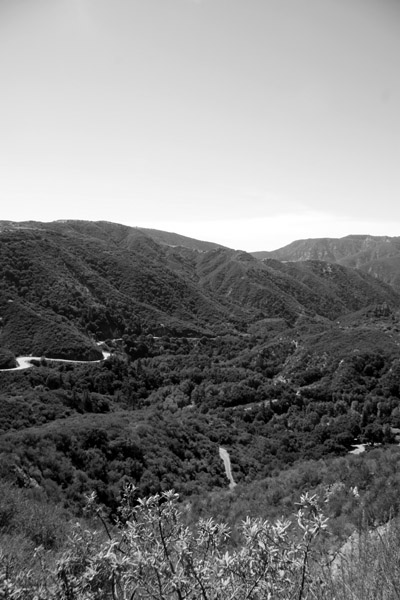
The black & white isn't a stylistic choice—he just didn't realize it was set for monochrome at the time.
On the way down, I admired the abundance of this pretty red-orange plant:
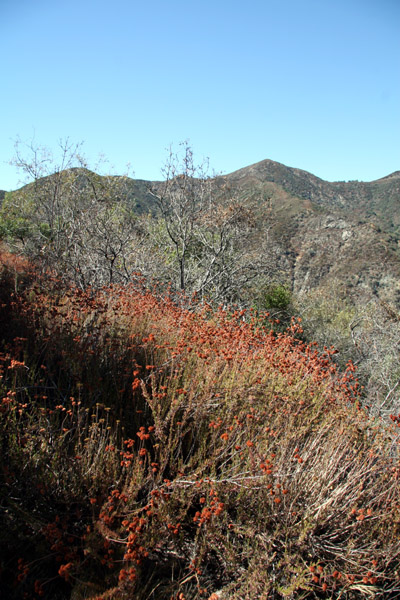
It really was all over the place, and it looked like a Southern California version of New England Fall leaves. In fact, the weather had cooled down during the last week, and I felt a distinct sense that Fall was right around the corner. However, the beginning of our hike was decidedly hot, and we were glad to descend into the shade of the canyon below.
Once down at Dutch Louie Flat, the first thing we noticed was the lack of any water in the streambed. Our book had promised a all-year stream flowing through the canyon. Instead, we found a rocky river bed covered in a layer of gray, dried-out algae. This lizard was chilling on top of said algae:
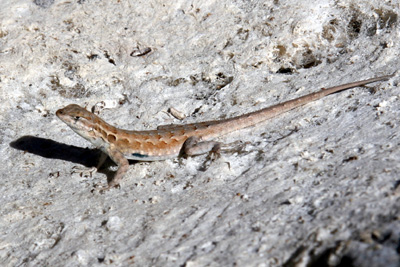
BF and I continued along, alternately hiking in the riverbed and along an indistinct path that wandered to and fro from the nonexistent stream. From the moment we arrived at Dutch Louie Flat, our hiking options were limited to climbing over large rocks or walking in soft sand. Neither choice was ideal, and the hike felt twice as difficult because of the uneven terrain. I knew I'd be sore the next day in all those weird side-leg muscles I never use during regular walking. (I was right.)
As we hobbled along, I suddenly saw this monster of a bug flying at my head:
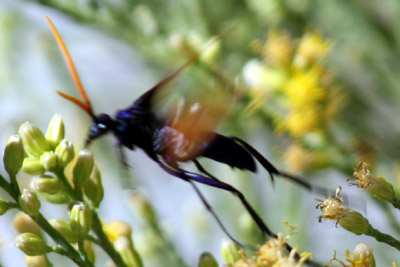
Aahh!
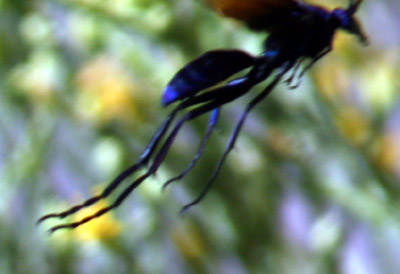
I screamed and ducked in the calmest way possible when a two-inch insect is hurtling towards your head. I believe I exclaimed "oh, damn!" as it flew towards me. Luckily, it passed me by and disappeared around the next bend. BF hadn't seen this bug, and when I described it to him he was incredulous. It probably wasn't that gnarly, I was just being girly, he figured.
So we moved on, hiking around the bend from whence the monster bug came, and discovered a sunny clearing dotted with pretty yellow flowering bushes. As we walked around exploring, I came very close to one of these flowering bushes and heard loud buzzing noises. I scuttled away quickly when I realized that the buzzing noise was emanating from a large beehive embedded in the center of the bush. When I was relatively certain that the bees weren't coming after me, I took a look around and realized that most of the bushes were covered in stinging, airborne insect life.
On one bush in particular, there was not just one monster bug, but probably a dozen of them. BF and I kept a safe distance away as he whipped out his telephoto lens:
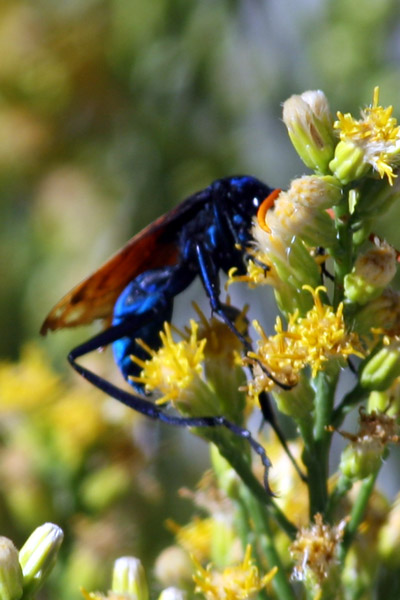
He took about 30 pictures of these critters, many of which are actually in focus. But I chose this shot because it captures the color of the bug well—shiny blue body and bright rust-colored wings.
When BF got home, he immediately did some research and discovered that the monster bugs were in fact called "tarantula hawks." Essentially, these are big wasps that hunt tarantulas. They hunt tarantulas, people! How hardcore is that?
Of course, as BF noted later in the safety of our home, the presence of so many tarantula hawks indicated the presence of tarantulas. Had we seen a tarantula, we might have been even more freaked out. (Author's note: I do realize that tarantulas aren't particularly poisonous to humans. Nonetheless, they still are big, hairy spiders, which is justification enough for me to run away from them.)
The other interesting thing about the tarantula hawk is its incredibly painful sting. For your consideration: an entomologist named Justin O. Schmidt ranks it near the top of his eponymous Sting Pain Index. His description of the pain is as follows: "Blinding, fierce, shockingly electric. A running hair drier has been dropped into your bubble bath (if you get stung by one you might as well lie down and scream)."
If BF and I had known this, we may have stepped back a few feet.
Once we had had our fill of the tarantula-eating insect, BF and I decided to keep heading down the canyon. We were almost ready to abandon our plan of finding landmarks described in the hiking book (an old tunnel, something called "Dagger Flat") but we just decided to keep going until we were certain we'd never come to an identifiable spot and then turn around.
We were both very glad we continued on, because shortly we came upon an awesome sight. There was a small pool of water with a little stream feeding it—what appeared to be the last remains of the stream—and standing in the pool was a huge bird:
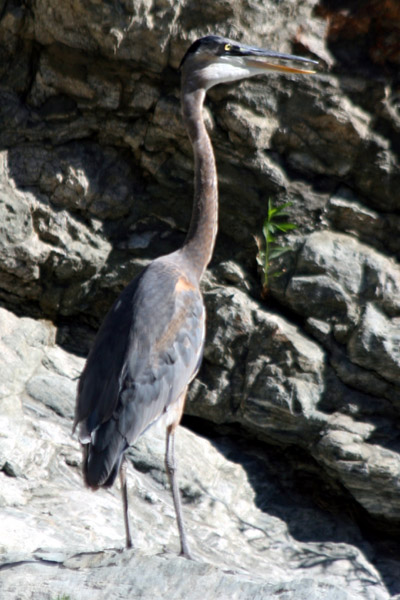
BF and I stealthily approached it, and snapped a million pictures of it going about its business. Here are some highlights:
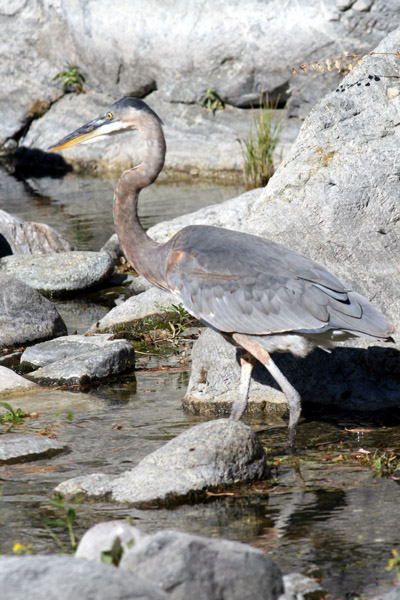
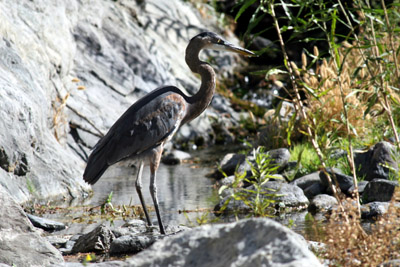
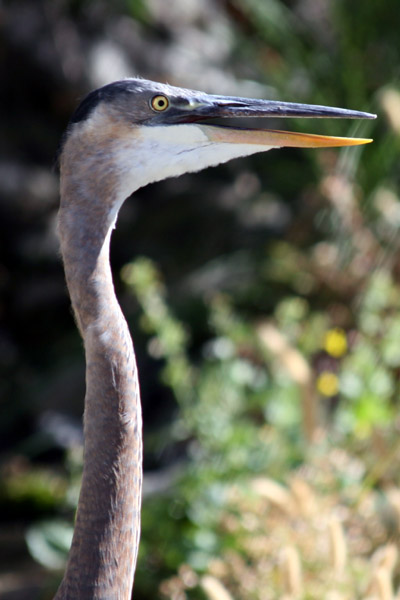
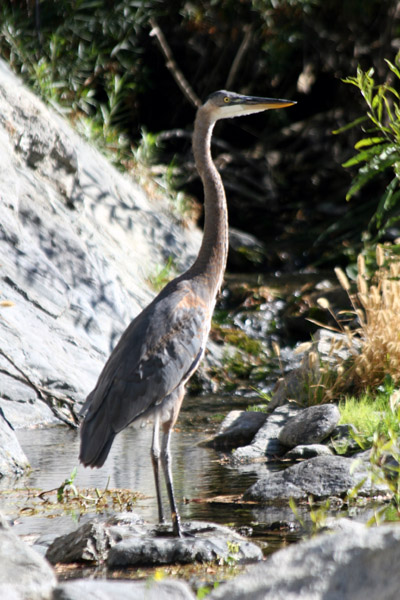
As we got closer, the bird fanned out its wings and stood up very straight. We're still not sure if this was a defensive stance or if it was just trying to warm itself in the sun:
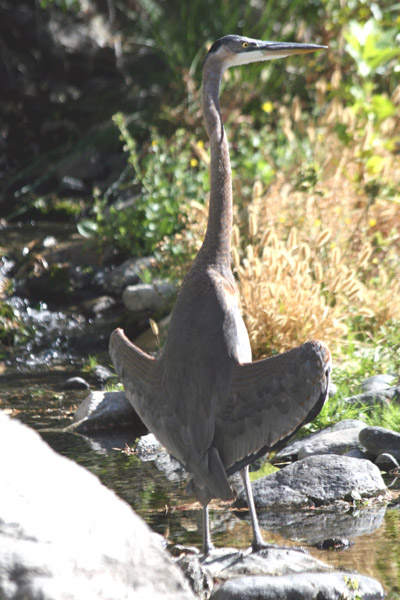
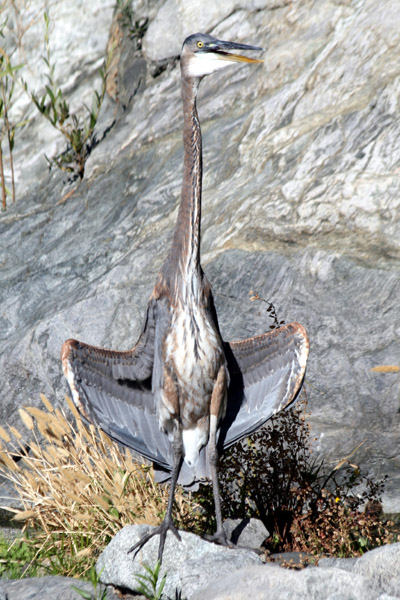
It was difficult to tear ourselves away from the bird, but we finally decided we had bothered it enough, and we moved on. We went another half mile before we finally gave up hope of the tunnel or Dagger Flat. BF claims he saw a deer, but it ran off before I could spot it.
One thing we did find a lot of was shotgun shells. They were scattered evenly all along the trail route. I'm not sure who was firing a shotgun out here, and I was not eager to run into a gun-toting maniac, so I was happy to head back out of the canyon. BF thought they might have been shooting at this old, rusted-out car:
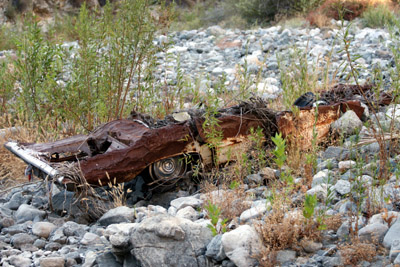
Back at our pool, our bird friend was still there. As we walked, it decided it had had enough of us, and it flew away:
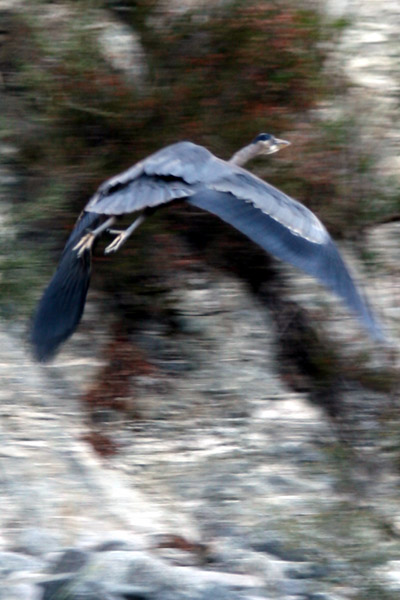
And so we headed back, keeping an eye out for the apocryphal tunnel. (We never found it.) The last leg of the hike was the uphill slog back up to Dillon Divide. I had to take it a bit slowly, but it wasn't as brutal as I had anticipated. Once up at the fire road, the sun started to set behind the lingering forest-fire smoke:

BF and I considered staying later to get a shot of the sun as it turned fire-engine red behind the smoke, but we were ready to get back to the car. We were both hungry, and we could hear In-N-Out calling our names. So we found the end of the trail and headed back down to the L.A. basin, but not without picking up some animal style burgers first.


2 Comments:
Nice story - I think that the bird was a Great Blue Heron.
I also think the bird was a blue heron. John Robinson's book does say the stream is year-round but after about May it is getting very dry. The hike is easier once you realize that the trail doesn't follow one side of the stream or the other, but instead crosses back and forth about 15 times to avoid boulders and cliffs that are hard to climb. Wear old sneakers without socks and just let your feet get soaked. Up from the creek, there are tons of old refrigerators, cars, and junk, all peppered with shotgun shells, it's someone's place to practice. I never saw the tunnel either. The orange plant may be "Mormon Tea", but I'm not sure.
Post a Comment
<< Home